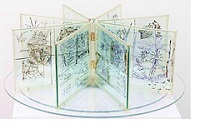Whether as ethereal multiples created with printing technologies, or as one-of-a-kind objects, accordion-fold artists books, Caydance observed, were in the air and would emerge ubiquitously in the coming years. But at this point, she had slides but not many actual examples to show her students. She would begin with past and future examples from Carolee Schneemann's work. The first would be a sprawling compendium of drawings, writing, charts, small objects, and unfolding insets: Parts of a Body House, published in 1972 by Beau Geste Press, in an edition of 60. Caydance saw this work in Carolee's New York City studio, and she remembered the interactive experience of unfolding this book/object -- while along side her in Carolee's studio, a student intern was restoring early wooden assemblages that Caydance had never seen before -- or since.

 In the classroom, a not-yet-completed work would materialize in slides of maquettes and drawings for a room-filling installation, where drawing-infused plexiglass panels would unfold from a center, and move in an environment of Schneemann's films -- as if the structure was an unfolded accordion book.
In the classroom, a not-yet-completed work would materialize in slides of maquettes and drawings for a room-filling installation, where drawing-infused plexiglass panels would unfold from a center, and move in an environment of Schneemann's films -- as if the structure was an unfolded accordion book.